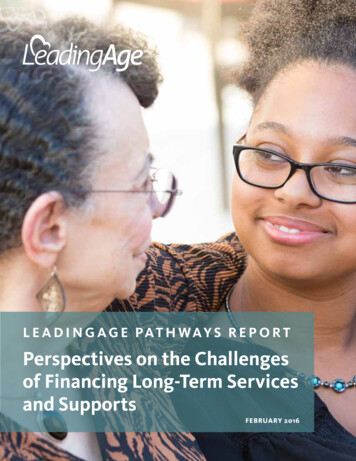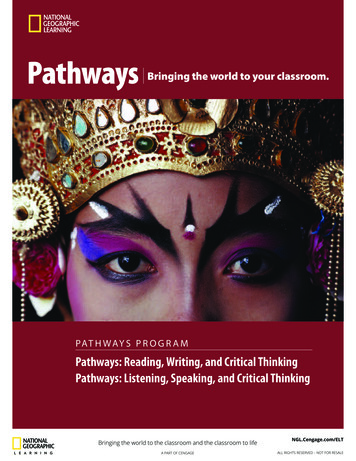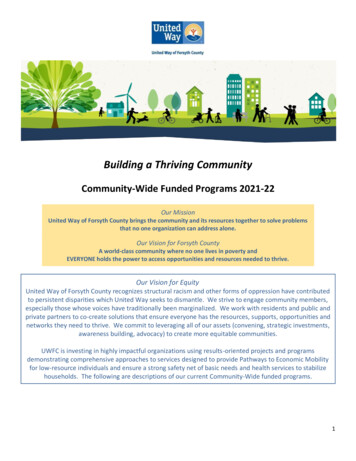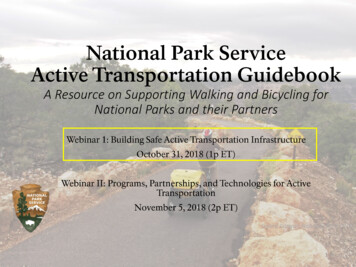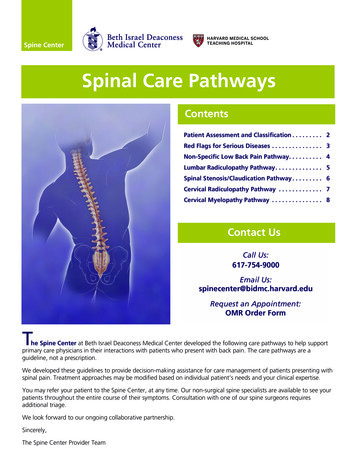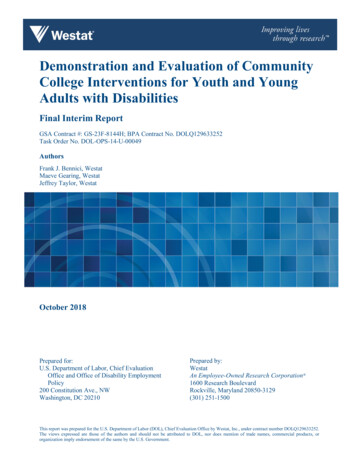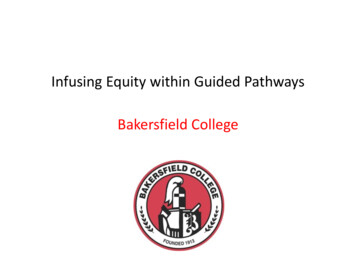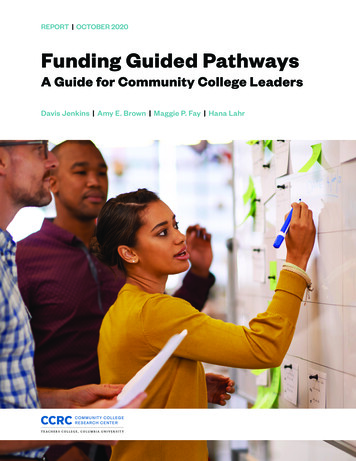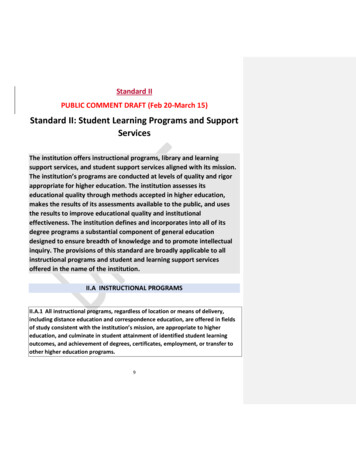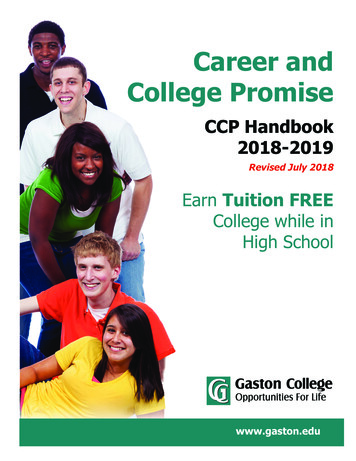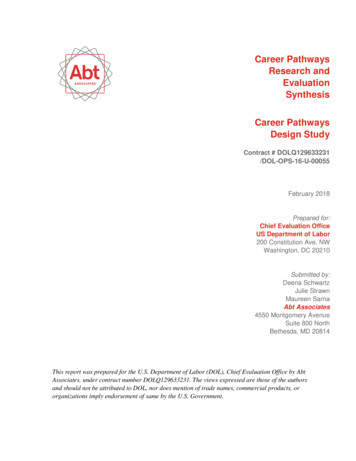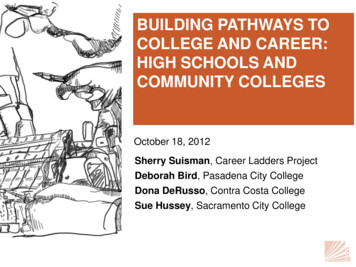
Transcription
BUILDING PATHWAYS TOCOLLEGE AND CAREER:HIGH SCHOOLS ANDCOMMUNITY COLLEGESOctober 18, 2012Sherry Suisman, Career Ladders ProjectDeborah Bird, Pasadena City CollegeDona DeRusso, Contra Costa CollegeSue Hussey, Sacramento City College
THE CAREER LADDERS PROJECTfosters educational andcareer advancementthrough research, policyinitiatives, and directassistance tocommunity colleges andtheir partners
LINKED LEARNING:A BRIEF DEFINITION Transforms students’ high school experience by bringing together strongacademics, demanding career and technical education, and real-worldexperience. Uses the above combination to help students gain an advantage in highschool, postsecondary education, and careers. Offers students the opportunity to follow industry-themed pathways,choosing among fields such as engineering, arts and media, orbiomedicine and health.(ConnectEd)
CORE COMPONENTS OFLINKED LEARNING A challenging academiccomponent A demanding technicalcomponent A work-based learningcomponent Support services
CCCLLI: A BRIEF OVERVIEW Funded by the James Irvine Foundation for 2012- 2014 Intensive work with three community college Hub Sites and (at least) ninepartner colleges Focus is on three industry sectors: Arts, Media and Entertainment(Pasadena City College), Health Science and Medical Technology(Sacramento City College), and Public Service (Contra Costa College) CLP is leading the initiative
COMPLETION BY DESIGN: PROGRAMPATHWAYCONNECTIONENTRYFrom interest toenrollmentFrom enrollment toentry into programof studyConsiderCollegeEducationPROGRESSFrom program entryto completion ofprogramrequirementsEnterProgramof StudyCOMPLETIONCompletion ofcredential of value forfurther education and(for CTE) labor marketadvancementCompleteProgramof StudyJenkins & Johnstone, REDESIGNING CC PROGRAM PATHWAYS for COMPLETION: Principles and Process,CBD Planning Retreats, February 2012
CCCLLI: STRUCTURE OF THE DEMONSTRATIONSacramento City CollegeSector: Health Scienceand Medical TechnologyContra CostaCollegeSector: PublicServiceStudentSuccessPasadena CityCollegeSector: Arts,Media andEntertainmentPartner Colleges
PATHWAY DEVELOPMENTPasadena City College—Design Technology Pathway Model
USE OF 2009 COHORT DATAStudent data showed that Linked Learning graduates were: Graduating high school at higher rates than their peersFrequently placed into remedial coursesUnfamiliar with the assessment examsNot in contact with a community college counselor
STRONG COLLABORATION WITH LINKEDLEARNING HIGH SCHOOL AND SCHOOL DISTRICT
EMERGING CORE COMPONENTS FROMCCCLLI PARTNERSHIP DISCUSSION Contextualized teaching and learningPrograms are all building on previous workStrong student support services (transitions)Each college actively doing research (in the form ofPAR)
PUTTING IT ALL TOGETHER: FOCUS ON COLLEGEREADINESS / TRANSITION Early assessmentMultiple assessments or measuresInvestigation of dual enrollment/bridge classesOther high school interventions and readinessapproaches
The AlliedHealth FacultyLearningCommunitySue HusseySacramento City College
Origin Formed in January 2012 under the HealthcareWorkforce Initiative – Bridging the DividePart of a project to develop a student alliedhealth learning community who enroll as acohort to complete prerequisites/general edcourses for allied healthTransdisciplinary group of 8 faculty members
Goals of our FLC To link the prerequisite & general educationcourses required for allied health programs inthe LRCCD to a common theme ofhealthcareEncourage reflection about teaching andlearningExamine best practices for student successTo foster a common language
Features of the Allied HealthFaculty Learning Community Bi-monthly,two hour meetings Membership increased from 8 to 16 Reflection papers Recommended readings on learning Individual and collaborative tasks
Activities of FLCLinking the CurriculumProfessionalDevelopmentCase Management ofStudents in the AHLCParticipatory ActionResearch
Challenges Requiresfaculty toquestion some oftheir own viewsand come to ashared view withtheir faculty teamabout how toteach together Increase in numberof membersSuccesses Hasbroken downthe silos betweendepartments Faculty don’t feelso isolated Faculty are thinkingabout teachingand learning likenever beforeFLC member: “I grasped how challenging collaboration isbut also, I glimpse, how satisfying when I think of the longterm consequences: a more linked world.”
CONTRA COSTA COLLEGE LINKEDLEARNING PATHWAYSEMS and Security Specialist as Gateways to Career DevelopmentSecuritySpecialistADJUSTransfer ASCorrectionsAS or CertsEMSLaw Enforce.ASor CertsFireScienceChronic CareNursing/MAAllied Health
CONTRA COSTA COLLEGEADMINISTRATION OF JUSTICE COHORTDEMOGRAPHICS2012-13 CohortCollegeAGE: Under 2087%22%AGE: 20 – 2413%23%96% directly from high schoolGENDER: Male70%40%GENDER: Female30%60%ETHNICITY: Hispanic87%26%BOG67%45%1st GENERATION72%AB540 students39%
COLLABORATION WITH HIGH SCHOOL Coordination with Law and Justice (year 1) and Health(year 2) Academies from local high schools Data indicates that students to not attend CCC atdesirable rates and fewer complete Initial meeting yielded a common list of outcomes forstudents and an agreement to narrow the gap betweenthe two institutions expectations of “college ready”through a series of interventions MOU to share student data
STRATEGIES TO NARROW THE GAP Early high school assessment Evaluation of high school writing samples by collegefaculty to assess accuracy of assessment instrumentand inform high school and college instructors ofstudents’ writing competency Development of interventions to build students skills toprepare them for college level work
INTERVENTION STRATEGIES Students enroll in concurrent college English class forSpring 2013 Winter/Summer Bridge Program Utilize online teaching/learning modules to developspecific skills Explore possible articulation for basic skills English class Mentors/tutors work with high school students to improveskills
STRATEGIES TO IMPROVETRANSITION TO COLLEGE Assist students in college application and financial aid College CTE counselors work with high school students on careerdevelopment and educational planning Students have a college transcript before leaving high school Articulation of Intro ADJUS course Construct a minimum of four activities that bring high schoolstudents to the college campus Pre-semester “boot camp” Enroll students in concurrent ADJUS course for spring 2013
TRANSFERABLE STRATEGIES Early Assessment Use your current outreach staff to provide CTE focusedvisits to college campus Concurrent enrollment gives students an authenticcollege experience and builds confidence in ability tosucceed in higher education
25,000 Students40% Aged 19 – 2142% Hispanic, 24% Asian PI, 18% White, 6% African AmericanBasic Skills Math (90%) English (75%)23% Enrollments CTE
5,000 Incoming Students1500 High School Grads800 in First Year Experience PathwayCollege ReadinessGuaranteed Blocked ClassesStudent SupportCohort Learning CommunitiesPathway Development
DESIGN TECHNOLOGY PATHWAY MODELProblems:Low Completion Rates in Engineering Technology ProgramsHigh Basic Skills NeedsOut of Date Technology and PedagogyPathway Piloted 2011/1281 Total Students over 3 cohorts
DESIGN TECH PATHWAYYear 1 – College ReadinessCollege 1Speech 1Design Tech 100Design Tech 101 (Fab Lab)Math 402 (Pre-Algebra)Math 125 (English 100English 1A (Freshman Comp)Year 2 – Workforce ReadinessNational certification – Work Keys, ABETYear 3 – Specialized DisciplineCertificate of AchievementAS DegreeYear 4 – Degree/Transfer
Engineering Technology PathwayOutreachMechanical/Electrical/Manufacturing OptionHigh SchoolArticulationsSummerUp StartNon ralEducationEnglishENGL 400ENGL 902GESocialScienceGEDiversityENGL 100ENGL hnologyCTEBUS 112DT 100DesignTechGEHumanititesGESpeech 1ENGL 1AENGL 1BCHEM 22PHYS 2AGEHistoryEngineeringGEPoli-SciGEHealthCHEM 1AGEP.E.CHEM 1BPHYS 1APHYS 1BFabricationMACH IIMACH IIIProductionWELD IIWELD IIIGraphicsEDT IIEDT IIIENGR 10ENGR 15AENGR 17ElectronicsELEC IIELEC IIIENGR 14ENGR 15BENGR 16MATH 7BMATH 5AMATH 5BMATH 5CMATH 55DT 101FabLabTECH 107AEngineeringRoboticsMathMATH 402MATH 125DesignTechCertificate17 UnitsMATH 131EngineeringTechnologyCertificate18 UnitsAS DegreeEngineeringTechnology60 UnitsMATH 7ADisciplineCertificates12 UnitsAS-T DegreeEngineering 60 Units
CCC Linked Learning InitiativePasadena High School53% Participation (216)Low Success Rates/GPAJohn Muir High School42% Participation (81)No Pathway Continuity
Bridge:Summer JamEarly Assessment Pre-assessmentDual EnrollmentOutreach CoachesFaculty Exchange
FOR MORE INFORMATIONSherry Suismanssuisman@CareerLaddersProject.orgSue Husseyhusseys@scc.losrios.eduDona DeRussodderusso@dvc.eduDeborah g
From program entry to completion of program requirements COMPLETION Completion of credential of value for further education and (for CTE) labor market advancement College Enter Program of Study Complete Program of Study Consider Education Jenkins & Johnstone, REDESIGNING CC PROGRAM PATHWAYS for COMPLETION: Principles and Process,
